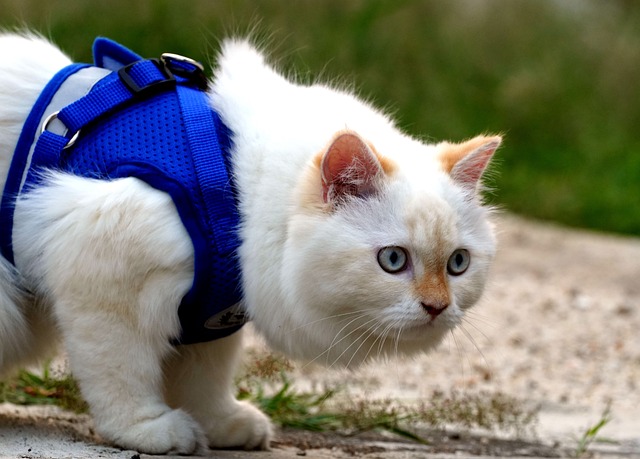Alright all my feline friends servants. Let’s talk about how to walk a cat on a harness and when it may be fun for you and your kitty.It can be a very fulfilling experience for your kitty cat and a good bonding experience between owner and feline.

All over the internet other cat owners are clamoring about how walking a cat is bad. Some shelters apparently even have clauses in their contracts that their cats will be house cats only. Which is a bummer to me since it is a great way to let your fur child explore their outer surroundings in a safe manner
Before starting. Assess your personal situation.
Ask yourself
Does your cat want to go outdoors, or are they terrified of it? If your cat is constantly staring out the window into the great outdoors he or she are probably interested in the chance to explore outside. Walking them is a great way to do it.
Are you just doing it for you? Some cats are just scaredy cats. Cat that are afraid of their own shadow are probably not going to want to enter an entirely different environment than the comforts of home. So simply don’t do it if you are only interested in crowding your Instagram feed with images of a shaky, nervous pet.
Do you own a good, sturdy harness? Does it have a solid clasp, good closure, and no way they can’t riggle out of it.
Do you have the patience for it? It takes the cat getting used too the harness and leash. Like for you women who try high heels on for the first time. Do you not feel and walk awkwardly at first? Same goes for your pet.
Location? Is your locale you chose too crowded? Choose a place to walk your cat with very little traffic to avoid the risk of them getting away and possibly getting ran over. If you have a quality harness this shouldn’t be an issue.
What are the challenges of walking a cat on a harness?
Cats are naturally independent creatures who for the most part don’t like being restrained. You have to slowly accustom a cat to wearing a harness preferably whenever they are just kittens. There are harnesses available specifically for kittens
Cats, like people, have different personalities and some take to walking better than others.
The challenge then is careful positive reinforcement training to get the cat used to the harness slowly over time.
Kitty cats also have a curious behavior of going limp when the harness is first put on. Some lay down. Some freeze. This is because their natural fight, flight, or freeze response kicks in due to their anxiousness kicking in. Their instincts will trigger this as is they were just nabbed by a predator.
The answer to this is to use a favorite toy or treats along with a lot of pats and praise.
Do NOT use a dog collar on a cat. This could cause harm to your feline friend. You need to use a cat harness to walk a cat – not Fidos leash!
Ready or a walk? Great
Who are cat harnesses for?
People who want to give their pets a new “leash” on life in the great outdoors would like cat harnesses. They would like a way to keep their feline in sight while the cat gets a new experience with fresh air and taking in a natural environment.
Another person’s situation could be that they want to get active too and think “Why not bring my cat with me too?” A walk is good exercise for the both of you. 30 minutes a day of walking can improve:
- Physical health
- Mental health
- Weight management
- Digestive health
- Immune system
- Creativity
- Bone density
People who have cats as therapy animals might want to walk their cats in public instead of carrying them everywhere. This leaves them an extra hand to pick groceries off the shelf. Many cats don’t like being carried everywhere either.
Getting cats used to the harness
Cats are very independent, so they don’t like being confined. What is more confined than a harness that wraps around their body? Not much. So they need some positive reinforcement to get used to the leash.
You know how Pavlov’s dogs worked, right? He rings the bell and then feeds his dogs and the dogs start to associate the ringing of the bell with the joy of eating. Pretty soon Pavlov was ringing the bell and the dogs were drooling even before food was poured.
Cats also have to have this positive reinforcement. Treats can be used for this or a really fun toy. The objective is to get cats to associate the harness with feelings of pleasurable things. So put the treats in front of their whiskers before putting on the harness.
Just use the harness first and leave the leash for another day. Your cat is already uneasy about fitting into a new contraption and is feeling anxious. You need to get them accustomed first to just the feeling of the harness before leading with a leash.

So, get your cat used to the harness before the leash is attached. They’ll feel pretty awkward like you did when you put your first suit and tie on-and your leash is the leash of corporate America, but that’s a different story. Anywho, cats need to first get comfortable in their harnesses.
You’ll notice that they’ll eventually be ready for walking as long as
- They’re the right cat. If they’re real fraidy cats maybe walking is not for them. Maybe, though, you just pulled the trigger way too fast and should ease off until they’re ready.
- You have the proper equipment. Equipment has gotten much better over the years to handle the objections of safety and comfort levels for Fifi.
- You’re location isn’t overpopulated. No city blocks where car traffic is crazy.
- You did the training properly and now have your friend pet comfortable in his new activity of taking a brisk walk. It’s good for both of you anyway.
Final Thoughts
So, cat’s need not be afraid when it’s time for a walk. It is up to you to get them ready if you so choose to do this. Just keep in mind the factors that determine if your cat is the right candidate to do so and train them properly to gently get them used to it.
Take in consideration their stress level. If they aren’t ready to take on the great outdoors, then you could have pushed too far too quick or they just aren’t meant for the outdoors. Hopefully the former.
Are they froze in place? Extremely vigilant and nervously looking everywhere? Shaking? Then slow it down. Go back to the house and start from square one.
Proper equipment to handle the job is another thing to consider. A proper harness such as the Rabbitgoo Harness and Leash is a good choice boasting 4 adjustable sizes and thirteen different color options.
And with the proper training in place you and your cat buddy are off to the races, or at least at a fast paced walk. If you liked this post or if I missed something you think should be included I’d be happy to hear from you. Just leave me a comment below and I’ll get back to you. Thanks.



This is a very interesting article as I have never seen an owner leash their cat for walking. I’m accustomed to seeing cats in the window, or roaming the landscape from neighbor to neighbor. I’m not a cat owner but have had dogs and walked them on leashes. I’d like to come across an owner who do leash their cat and I’d watch the cat’s behavior and personality in amazement. The video shown was insightful and informative. If I had a cat, I would find a local class that might train the owner and cat being leashed as they do for dogs. It is true that cats have personalities and they all are not the same but different and unique. I enjoy your article and thanks for sharing your knowledge.
People need to be trained as well as their feline companion. I’m glad you found the post informative. Cheers
I have to admit, I never thought walking a cat on a harness could be a real thing, until now. My previous cats would have never tolerated the idea, let alone let me put a harness on them! Honestly, I would never have understood how to even approach this process until reading your guide. The detailed steps about easing them into it with positive reinforcement and picking the right equipment has really changed my perspective. I can now see how this could be an enriching experience for the right cat. I will, most definitely, be sharing this helpful guide. Thanks for sharing such an insightful and practical post!
Best wishes,
-Nick
Hey Nick, most people don’t know that you can walk a cat. It is best though to get them started at an early age. It would definitely be harder to get an older cat to do it because they are really set in their ways. It’s also not as easy as with a dog because cats are much more independent-minded, but it can be done. Thanks for your comment
Walking a cat on a harness can indeed be a great way to enrich their experience and strengthen the bond between you and your feline friend. Your guide provides a thoughtful approach to considering whether a cat is suitable for walking and how to go about introducing them to the harness and leash.
I appreciate the emphasis on assessing the cat’s personality and comfort level, as well as the reminder to use proper equipment like a cat-specific harness.
Thanks for sharing this informative guide on cat walking.